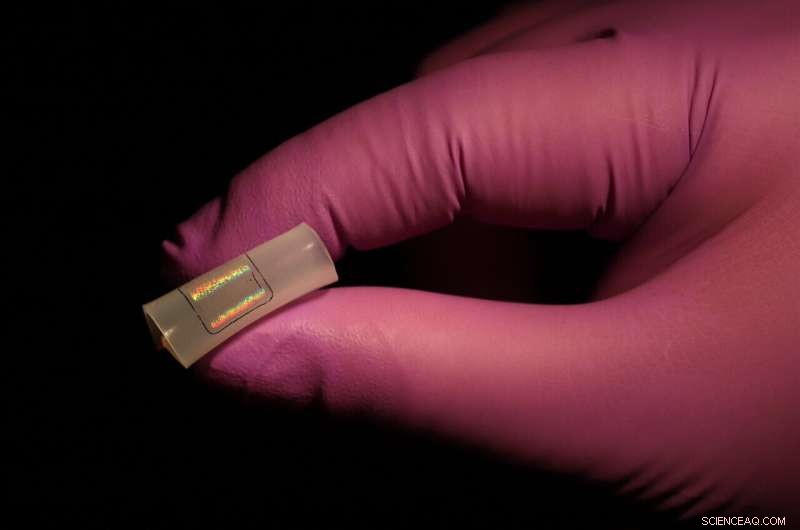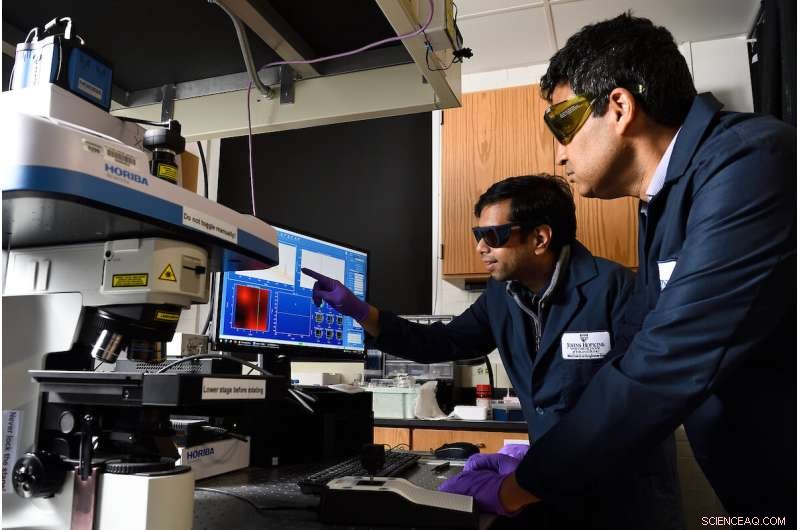
Il materiale del sensore può essere posizionato su qualsiasi tipo di superficie, dalle maniglie delle porte e gli ingressi degli edifici alle maschere e ai tessuti. Credito:Kam Sang Kwok e Aishwarya Pantula/Johns Hopkins University
Un sensore COVID-19 sviluppato presso la Johns Hopkins University potrebbe rivoluzionare i test dei virus aggiungendo precisione e velocità a un processo che ha frustrato molti durante la pandemia.
In un nuovo studio pubblicato oggi su Nano Letters , i ricercatori descrivono il nuovo sensore, che non richiede la preparazione del campione e la minima esperienza dell'operatore, offrendo un forte vantaggio rispetto ai metodi di prova esistenti, in particolare per i test su tutta la popolazione.
"La tecnica è semplice come mettere una goccia di saliva sul nostro dispositivo e ottenere un risultato negativo o positivo", ha affermato Ishan Barman, professore associato di ingegneria meccanica, che insieme a David Gracias, professore di ingegneria chimica e biomolecolare, sono autori senior dello studio. "La novità principale è che si tratta di una tecnica senza etichetta, il che significa che non sono necessarie ulteriori modifiche chimiche come l'etichettatura molecolare o la funzionalizzazione degli anticorpi. Ciò significa che il sensore potrebbe eventualmente essere utilizzato in dispositivi indossabili".
Barman afferma che la nuova tecnologia, che non è ancora disponibile sul mercato, affronta i limiti dei due tipi di test COVID-19 più utilizzati:PCR e test rapidi.
I test PCR sono estremamente accurati, ma richiedono una complicata preparazione del campione, con risultati che richiedono ore o addirittura giorni per essere elaborati in laboratorio. D'altra parte, i test rapidi, che cercano l'esistenza di antigeni, hanno meno successo nel rilevare infezioni precoci e casi asintomatici e possono portare a risultati errati.
Il sensore è sensibile quasi quanto un test PCR e conveniente quanto un test antigenico rapido. Durante i test iniziali, il sensore ha dimostrato un'accuratezza del 92% nel rilevare SARS-COV-2 nei campioni di saliva, paragonabile a quella dei test PCR. Il sensore è stato anche molto efficace nel determinare rapidamente la presenza di altri virus, inclusi H1N1 e Zika.
Il sensore si basa su litografia a nanoimpronta su vasta area, spettroscopia Raman con superficie migliorata (SERS) e apprendimento automatico. Può essere utilizzato per test di massa in formati di chip usa e getta o su superfici rigide o flessibili.
Key to the method is the large-area, flexible field enhancing metal insulator antenna (FEMIA) array developed by the Gracias lab. The saliva sample is placed on the material and analyzed using surface-enhanced Raman spectroscopy, which employs laser light to examine how molecules of the examined specimen vibrate. Because the nanostructured FEMIA strengthens the virus's Raman signal significantly, the system can rapidly detect the presence of a virus, even if only small traces exist in the sample. Another major innovation of the system is the use of advanced machine learning algorithms to detect very subtle signatures in the spectroscopic data that allow researchers to pinpoint the presence and concentration of the virus.

Ishan Barman, left, and David Gracias observe the spectral signature measured by the Raman microscope, foreground, and uncovered by the machine learning algorithm. Credit:Will Kirk/Johns Hopkins University
"Label-free optical detection, combined with machine learning, allows us to have a single platform that can test for a wide range of viruses with enhanced sensitivity and selectivity, with a very fast turnaround," said lead author Debadrita Paria, who worked on the research as a post-doctoral fellow of Mechanical Engineering.
The sensor material can be placed on any type of surface, from doorknobs and building entrances to masks and textiles.
"Using state of the art nanoimprint fabrication and transfer printing we have realized highly precise, tunable, and scalable nanomanufacturing of both rigid and flexible COVID sensor substrates, which is important for future implementation not just on chip-based biosensors but also wearables," said Gracias.
He says the sensor could potentially be integrated with a hand-held testing device for fast screenings at crowded places like airports or stadiums.
"Our platform goes beyond the current COVID-19 pandemic," said Barman. "We can use this for broad testing against different viruses, for instance, to differentiate between SARS-CoV-2 and H1N1, and even variants. This is a major issue that can't be readily addressed by current rapid tests."
The team continues working to further develop and test the technology with patient samples. Johns Hopkins Technology Ventures has applied for patents on the intellectual property associated it and the team is pursuing license and commercialization opportunities.
Authors include:Kam Sang (Mark) Kwok, a graduate student in Chemical and Biomolecular Engineering; Piyush Raj, a graduate student; and Peng Zheng, a post-doctoral fellow in Mechanical Engineering. + Explore further